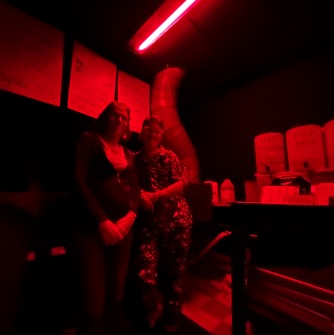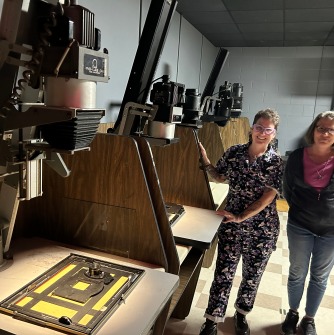| Contact |
Dustin Luca
|
|---|
SALEM, MASS. – Room 312 in Salem State University’s Meier Hall is one of the darkest places on campus. A sticker on the door helps clue visitors in on why: “stay positive, shoot negatives.”
The space has served as a darkroom for black and white photo development since its formation in 1985. It has survived the transition of photography through digital cameras and now handheld devices, and as the space approaches its 40th anniversary next year, programs relying on the darkroom are seeing a retro-driven resurgence.
“We’re going to need to make a schedule for the door again,” exclaimed Jessica Martineau ‘01, an adjunct faculty member in the university’s Art + Design department who helps run the space. “We have so many people overlapping, wanting to use the darkroom when other classes are here. It really, truly feels like it has come full circle.”
The darkroom occupies the space of what was once two classrooms on the third floor of Meier Hall. With all windows covered to block any outside light, the entire space is lit by white fluorescent lighting. But with a single light switch flip, the entire space plunges into darkness regardless of the lighting conditions outside.
At first, all one can see is glow-in-the-dark tape outlining paths on the floor and the boundaries of each of 15 photo development stations. After a few minutes of eyes adjusting to the dark, three dim red fluorescent ceiling lights provide adequate lighting to work in the space.
“I come from a time when this was the place to be. It was open 24 hours a day,” Martineau said. “People would have the radio on, and they’d be here all hours – printing.”
But the popularity of film-based photography wouldn’t last: a transition in the market loomed on the horizon.
“I took the very first digital class in 1998. Commercial photography and portrait photography were still film-based,” Martineau said. “At one point, there were 50 students using this darkroom, and we had other darkrooms at that point – color darkrooms – and advanced enlargers in other darkrooms. For the most part, this place was hopping.”
The advent of digital cameras in the late 1990s gave consumers nation-wide an option for photo-taking that involved no film processing, no chemicals, and no darkroom – budding shutterbugs needed only a camera, memory card and inkjet printer to become a photographer.
By 2018, 20 years later, the color darkroom had gone offline and the remaining black and white darkroom was at threat of extinction, according to Kimberly Mimnaugh, a staff assistant in the Art + Design department.
“There was a lot of people eyeing this space,” Mimnaugh said. “We both had the same idea that we needed to really bring it back to the community, including all majors – opening it up to everybody. That has been our concept: ‘Let’s get everybody into this medium.’”
Now, classes that use the space all semester fill their rosters in less than an hour, with students enrolled crossing all majors and schools. Many of those students are coming together to form a film photography club.
“It has been gratifying to see people back here and really enjoying and love it, and wanting to do more,” Martineau said.
That’s because photo development by hand is much more than just the retro chemical process that defines it. Each roll of 35 mm film provides a photographer limited real estate to work – typically 36 frames – with no opportunity for do-overs, deleting, or other novelties of the digital era. Even further, each step in the development process impacts the photo irreversibly.
“Every single print is made individually,” Martineau said. “We had something last night where somebody made a print, and they tried to make the same print the same way. ‘Wow, the shirt is lighter on this one…’ All it takes is a breath, whisper of time under that light and it’s a different exposure on paper.”
For that, black and white photography has transitioned from being a commercial interest in the 1990s to an art style in the 2020s, according to Mimnaugh. Having started at Salem State in 1991, she has seen the full transition.
Many graduates of the program are as resilient with the craft as the darkroom itself, Mimnaugh suggested.
“What I’ve seen over my career is that people don’t just want commercial work anymore. They want lifestyle, want things that look natural and not fabricated,” Mimnaugh said. “A lot of the people who have graduated from here, I follow their work – and that’s the style they’re still using.”


